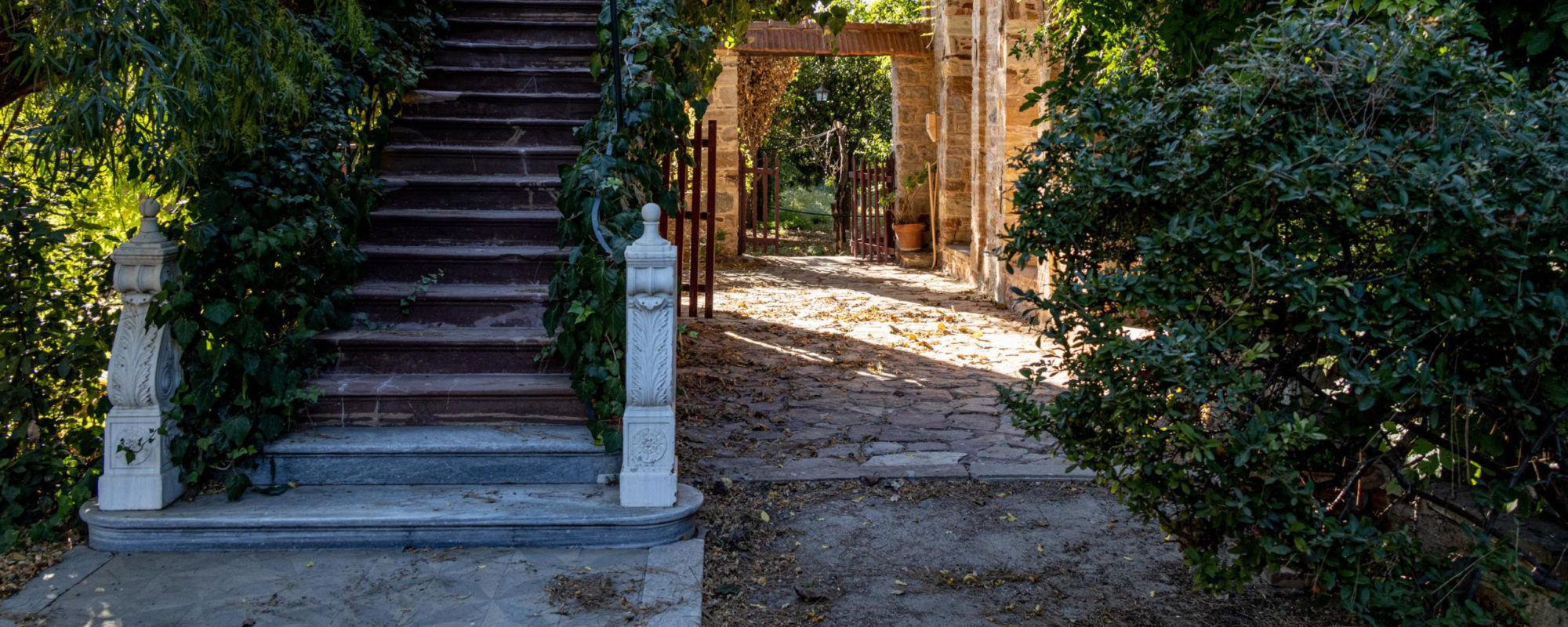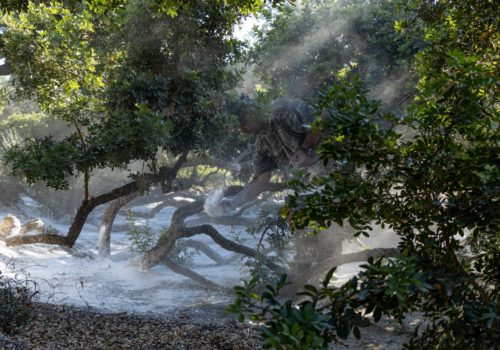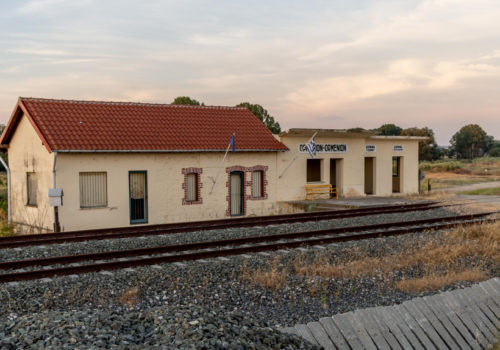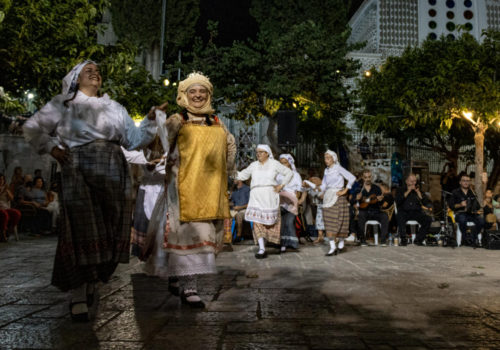KAMPOS, Greece — Before I ever tasted a Chios mandarin, set foot inside a shaded pebble courtyard or learned what calamities befell the rich merchant families who built their summer homes here, the walls of their estates piqued my curiosity. Every time I approached town from the southern mastic-producing villages, rust-colored Thymianan limestone rose up on either side of me. The road narrowed and twisted around the sharp corners of tower-like buildings with only a few well-placed mirrors to prevent collisions with oncoming cars. There were no places to stop or yield, not even a sidewalk, increasing the claustrophobia I felt.
Sometimes I glimpsed the top of a mansion or saw a pomegranate tree dangling its red fruit over a wall. In some places, portions of earth-colored stone had crumbled away, revealing dense citrus orchards. It reminded me of my grandparents’ neighborhood in Manila, which has the same air of faded grandeur. We spent Christmas breaks with them when I was a child, and I remember arriving from the airport late at night and waiting in the darkened car for the driver to open the large metal gate to my grandparents’ compound. Over the gate, a red, star-shaped lantern shone from my aunt’s window, hinting at the treasures within.
Six miles south of town, the Kampos of Chios is a fertile plain roughly seven kilometers long and three kilometers wide that in its heyday consisted of 225 historic estates and 38 churches. The region was first settled by the Genoese, who ruled the island from 1346 to 1566, using it as a trading post and way station linking the Western Mediterranean to Asia Minor and the Black Sea. Genoese nobles organized the island’s economy around luxury goods like the healthful mastic resin, silk and citrus fruits, which they introduced to Chios. They planted orange, lemon and later mandarin trees on enclosed country estates with stone tower-houses called pyrgoi.
Under Ottoman rule from the 16th to 19th centuries, Chios enjoyed many privileges, including relative political autonomy, religious freedom and relaxed taxation. It was a period of unrivaled growth and prosperity for Kampos. Powerful merchants like the Mavrocordato, Calvocoressi, Argenti, Ralli and Schilizzi families developed trade networks that extended to Constantinople, London, Odessa, and even New York, Alexandria and Calcutta.
By sharing trade information within those networks, they amassed great wealth, which they used to convert the pyrgoi into luxurious summer residences. That affluence nurtured a class of Chian intellectuals and artists with strong ties to the West who would play leading roles in the formation of the Greek state.
Two catastrophes in the 19th century extinguished Kampos’s golden age, however. During the Greek Revolution in 1822, Ottoman troops responded to an insurgent attack on a Chian garrison by slaughtering some 42,000 islanders, over a third of the population, and selling another 52,000 into slavery. The forces looted and burned Kampos, and survivors fled the island, many never to return. Half a century later, in 1881, a devastating earthquake reduced the neighborhood to ruins.
After the quake, Chian diaspora—mostly from Egypt—brought some wealth back to Kampos, building many of the mansions one sees today, often on the remnants of leveled pyrgoi. Citrus fruit remained a lucrative export until 1960, when competition from large-scale growers in the Americas caused prices to collapse.
The estates were sold and partitioned, and today fewer than 40 mansions remain, most of which are historic listed monuments. In the 1990s, the Greek government designated Kampos a “Historic Site” and “Traditional Settlement,” implementing building regulations to protect it. Europa Nostra, a civil society campaign to save European heritage sites, selected Kampos for its 7 Most Endangered Program in 2016.
Who lives within the high walls now? I wondered. What unseen worlds do they contain? As I left the busy streets and relentless traffic behind, Kampos began to seem more like a neighborhood. I spent afternoons wandering down quiet, shaded lanes, appreciating the smell of citrus and jasmine in the air, hoping an open gate might offer me a glimpse into a walled garden.
“Kampos is a fairy tale place, semi-ruined and abandoned,” said tour guide Thomas Karamouslis, who spent his childhood there. “Its residents were always a little eccentric, each locked in their own orchard, or perivóli.”
Here, there are clear distinctions between insiders and outsiders. “Alone, we might be jumping on furniture, but when someone came to the door, we spoke in the plural form and played perfect, civilized people,” he said. “We considered it normal.” The walls give Kampos an air of secrecy, and since most mansions are privately owned, it’s subject to much conjecture and gossip. Everything you hear must be taken with a grain of salt.
I got to know the Kampousoi slowly, as one resident introduced me to another. I ran into familiar faces on my long walks, and they opened churches for me and welcomed me into their homes with spoon sweets made from their perivólia, a local tradition. From September to December 2022, as the mandarins ripened and began to fall, I visited estates in various conditions and took thousands of photos. Every time, I discovered something new, something that surprised me.
Kampos testifies to Chian business acumen and the island’s international orientation, a trend that continues today as shipowners and diaspora restore long-neglected mansions. Each estate was once a self-sufficient ecosystem whose residence and farmland functioned in harmony. Despite numerous challenges to Kampos’s economic, architectural and environmental sustainability, many of the inhabitants I spoke with are invested in its survival and have hope for its future. As they try to protect and redevelop Kampos, I invite you to join me on a photographic journey within the walls of this historic neighborhood, to a hidden and interior world.
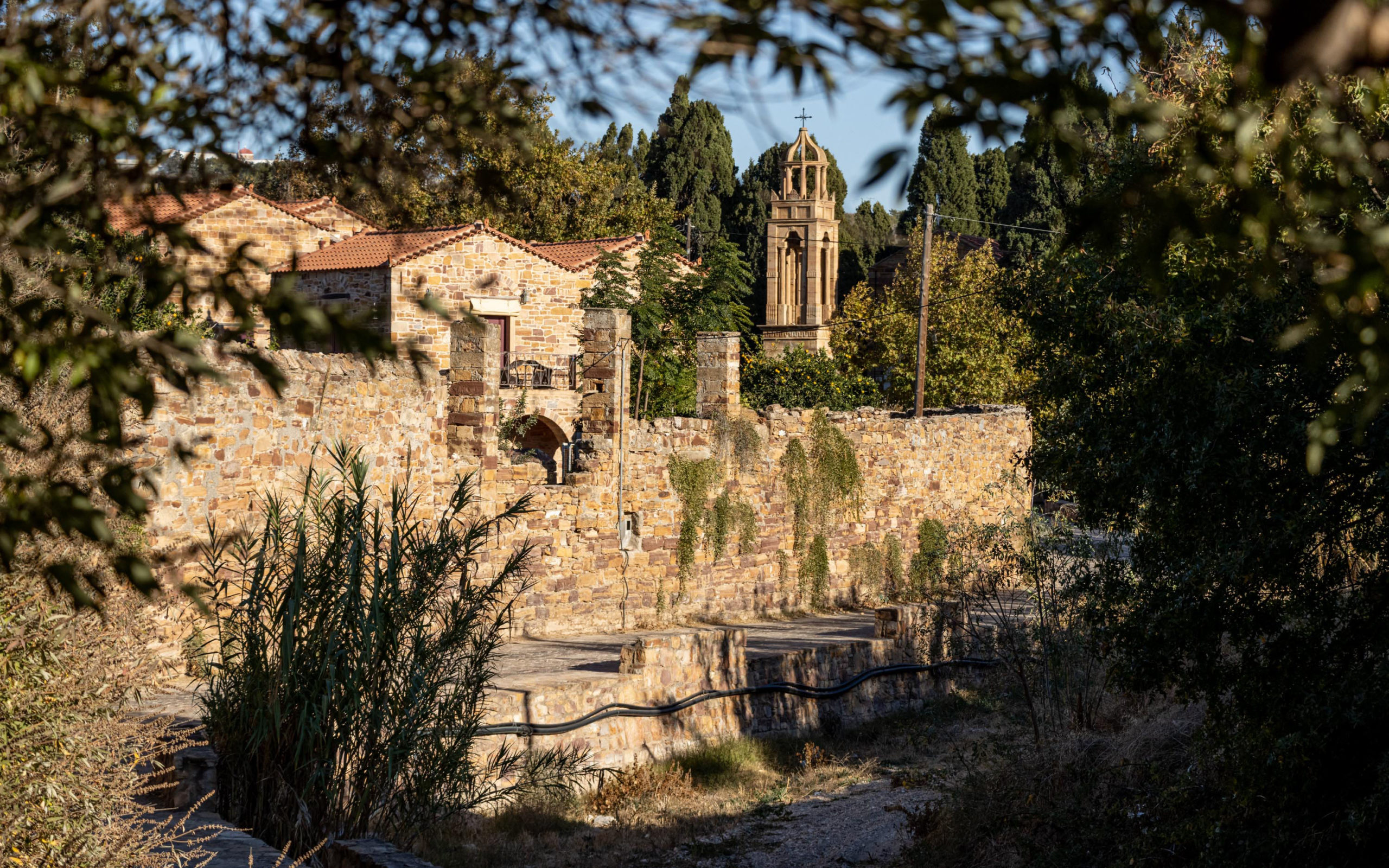
Within its boundary wall, each estate contained a mansion, well, cistern, fields and stables as well as workers’ lodgings and buildings to store and process citrus fruit. These characteristic architectural elements were combined in hundreds of appealing ways. “Each has its beauty and its personality,” said Vangelis Xydas, who operates the Perleas estate, now a guesthouse that specializes in agritourism activities. “They’re like people. We all have eyes, noses and ears, but each person has their own face.”
Narrow Aristeidi Karava Street, named after the Greek poet who spent his life in Kampos, runs along the Kokkalas stream, leading to the Riziko estate and the church of Panagia Syriotissa. Lia Forou, owner of the Karaviko estate, recalls that before the road was built in the late 1980s, she had to cross the stream to get to church.
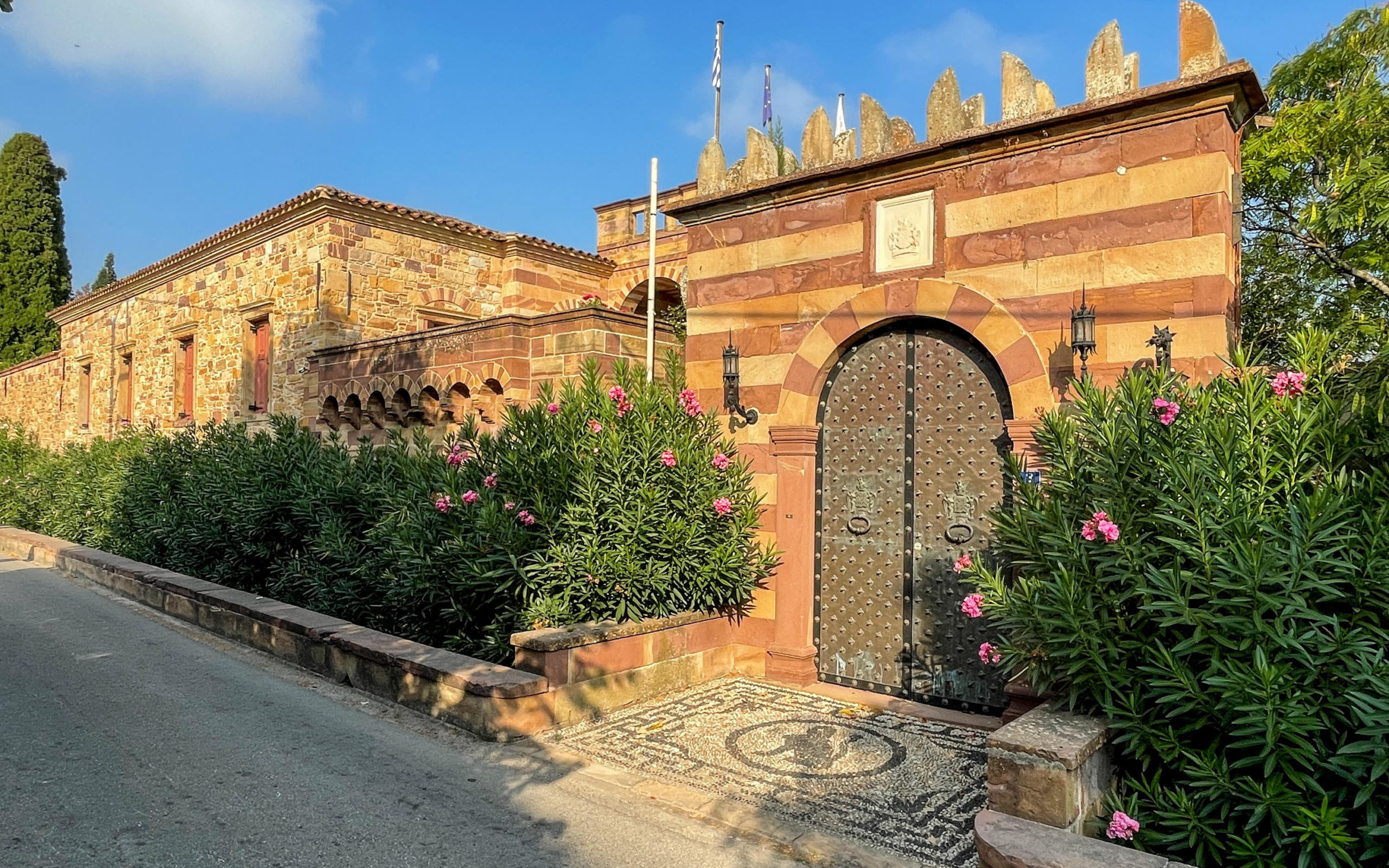
The first feature one notices from the road is the monumental entrance gate, often with an arch made of alternating colors of Thymianan limestone and the family’s coat of arms in stone relief. The gate of the Argentiko estate also features ornate bronze and copper doors with the coat of arms repeated and a votsalotó or “pebble mosaic” floor in the shape of a sphinx, the symbol of Chios. The gate reflects the aristocratic family’s wealth and power. The estate was built by the Genoese Argenti family around 1550 and remained in the family until recently, when it was sold to a shipowner.
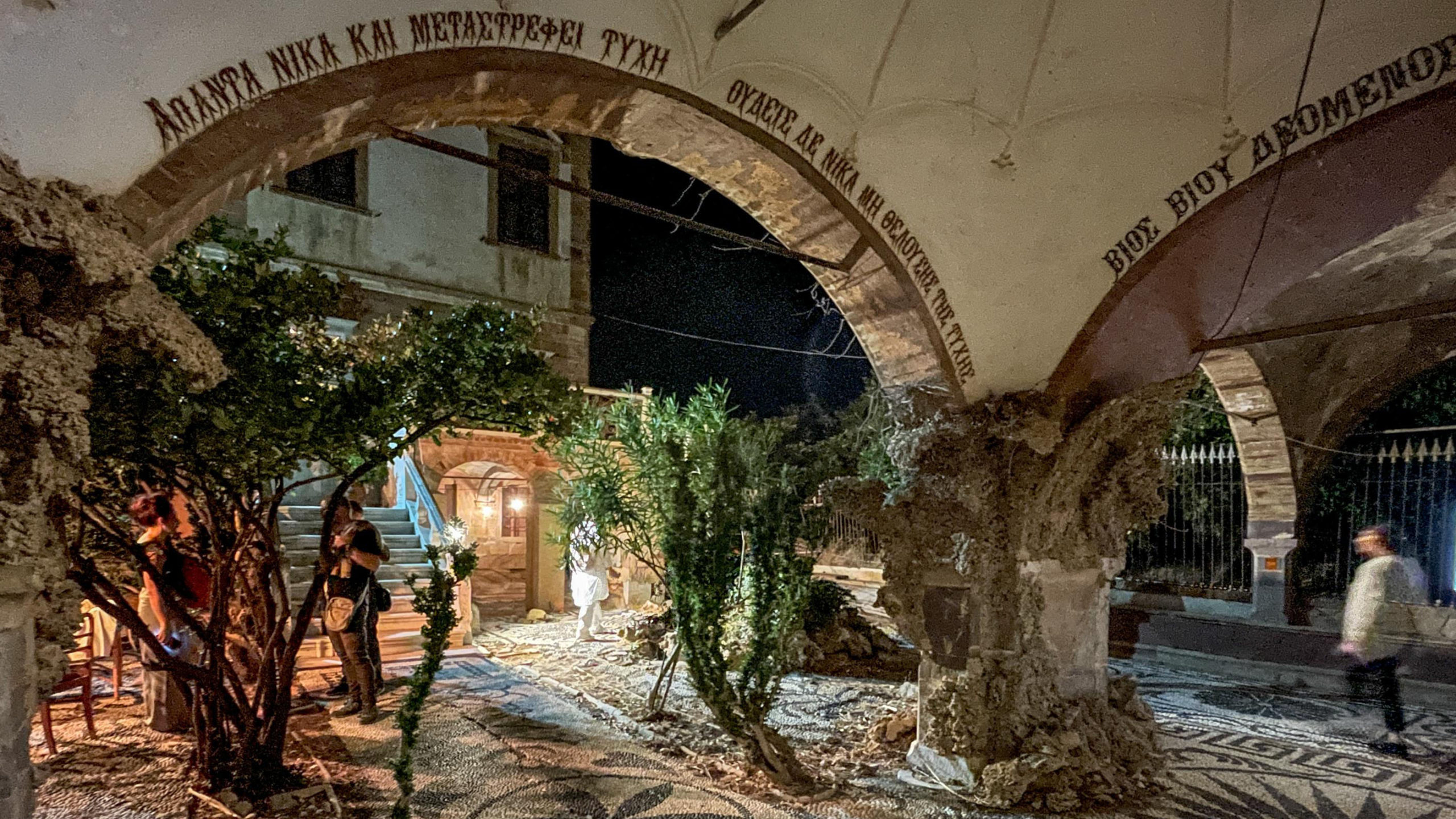
The gate opens onto a tranquil, shaded courtyard, and the reveal is often quite breathtaking. The courtyard functions as an outdoor sitting room and living space. Here, at the Zygomaladiko estate, we see more votsalotá and a unique domed entryway with clay mortar around the columns reminiscent of a cave or grotto. The inscription above the arch reads, “Fate overcomes and changes everything. No one can win unless fate desires it.” The mansion was built in 1863 by the banker and shipowner Michail T. Zygomalas. It now hosts hatha yoga classes, reflexology and massage sessions.
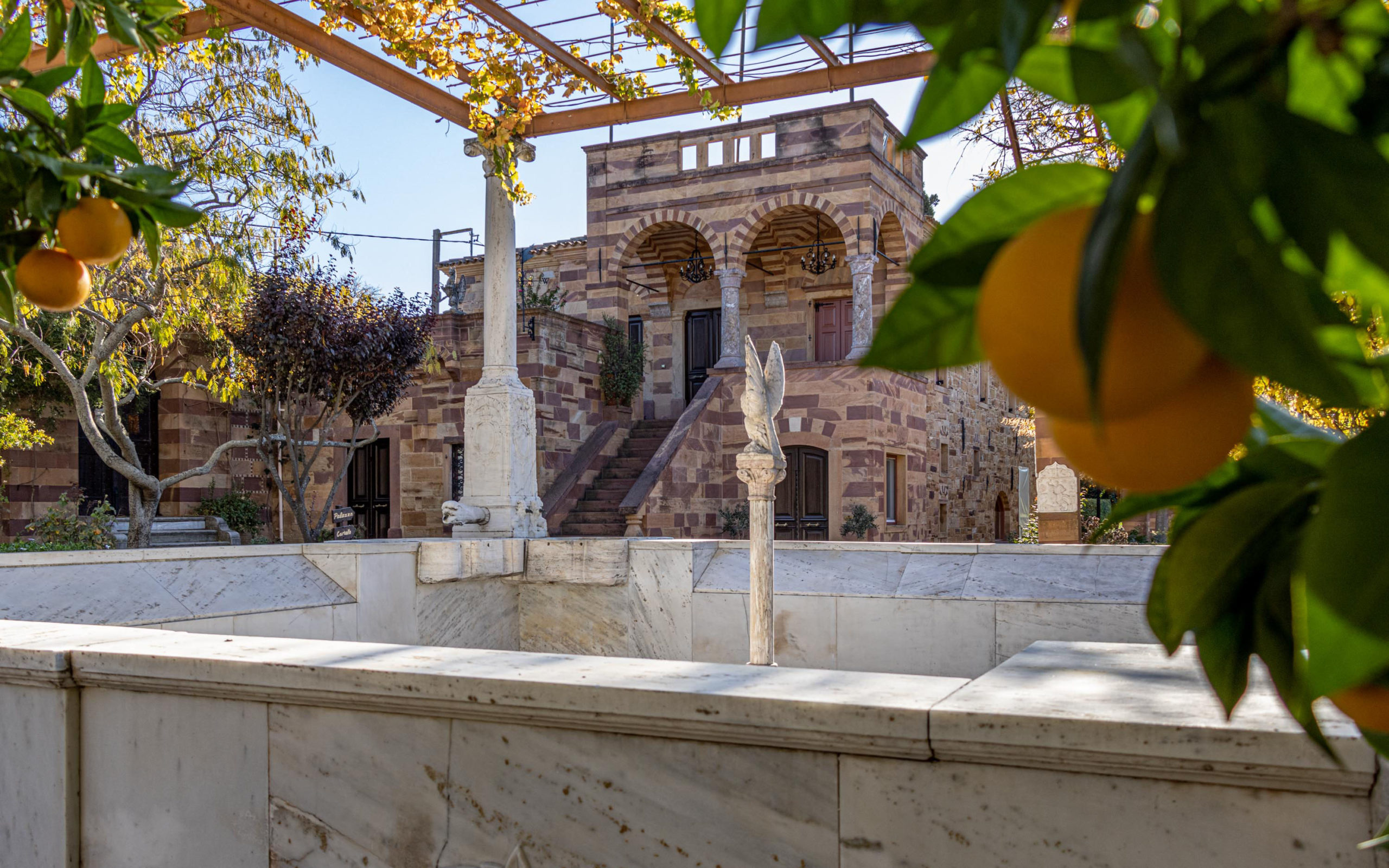
Kampos mansions are generally two or three stories high with one side flush to the street. Lower floors were used for storage, workrooms and stables, while the smaller upper floors, accessed via a large external staircase, contained living spaces. When residents converted the old pyrgoi into mansions in the 17th and 18th centuries, they added decorative architectural elements like columns, archways and balconies. Returning to Chios a century after the massacre, Philip Argenti found the family estate in ruins. He and British architect Arnold Smith began restoring the Argentiko in 1920, and though they did not rebuild the main residence to its original size, today it is considered a prime example of Kampos’s former grandeur. It now operates as a luxury hotel. The water reservoir, made entirely of Pentelic marble, is one of a kind.

Some of the interiors I visited, like this sitting room at the Michalou estate, made me feel like I was stepping back in time. Lucy Vandoros, the present owner, told me her grandparents bought the estate around 1890, probably when they got married. They added this dining room to the side of the house in the early 1930s. Lucy has kept all her family’s original furniture, and the house is filled with heirlooms and photographs dating back at least 100 years. There’s even a gramophone and a pianola.
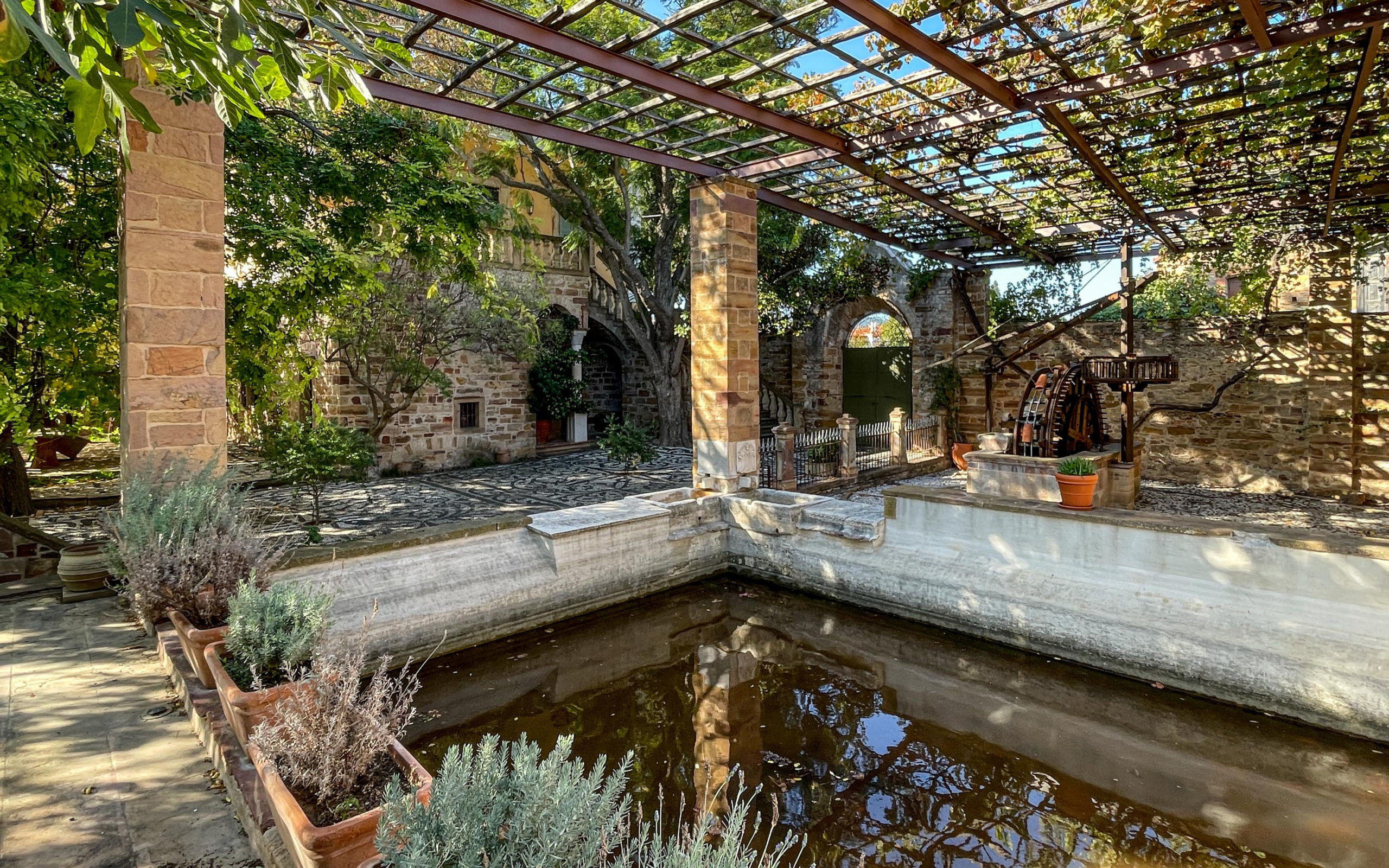
Water was always in high demand, and irrigation needs informed the estates’ design. The well and its wooden water wheel, called a mánganos, forms the heart of each estate as it supplies water to the orchards and fields. The depth of the well varies from 14 to 50 meters. It is traditionally powered by a donkey walking along a circular track, although today most owners use electric pumps. As it turns, terracotta buckets bring up water from the well.
Water flows from the mánganos to a nearby rectangular cistern or stérna, where it is stored until needed. The stérna at the restored Antouaniko estate is from the mid-18th century, predating the mansion. One of its marble basins features carved tulip, triangle and disc motifs characteristic of the Ottoman period. The stérna at the Karaviko estate has marble spouts in the shape of lion and serpent heads. Some contain goldfish.
A pergola usually covers the mánganos and stérna to prevent evaporation, creating a cool microclimate within the estate. Kampos resident Giorgis Mastorakis remembers working on an estate as a teenager. “The orchard, the mansion, the stérna all have a color, a style, a calm,” he said. “It was an opportunity to live with nature. The sound of the mánganos drawing water, the symphony of frogs in the stérna at night, the birds, the lack of airplane noise. All that has been lost.”
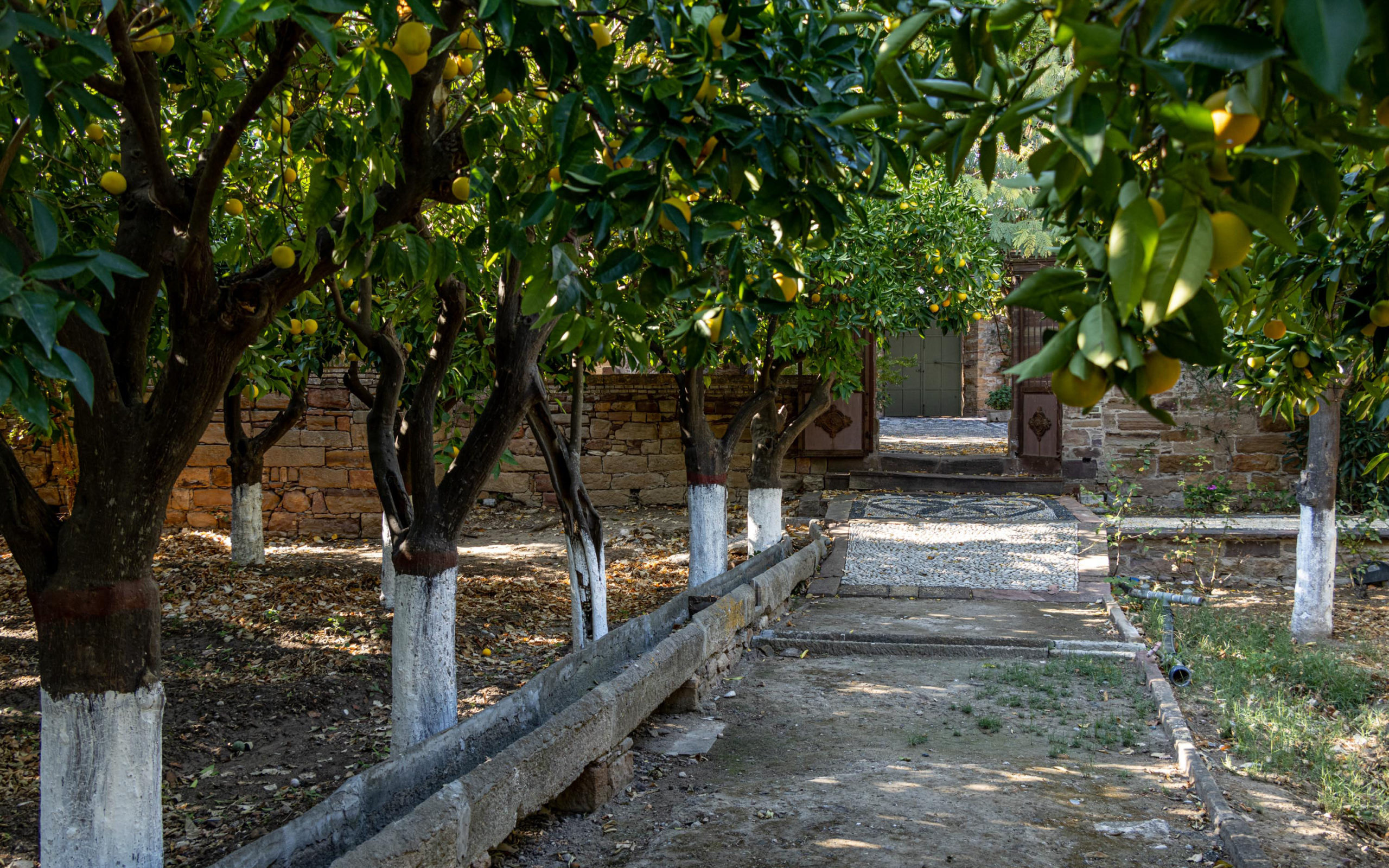
A gate often separates the open courtyard from the citrus grove, where the trees stand in ordered rows “like soldiers,” as one caretaker told me. The dense cultivations slow evaporation, prevent weeds from growing and help protect trees from the cold. At the Antouaniko, the orchard is still watered in the traditional way, with irrigation canals. From the stérna, water runs down sandstone channels to the orchards, where it is directed into furrows dug around the trees. Laura Benzonana, who owns the Mitarakiko estate, recalls playing in the canals when she was three or four years old. “They had the most freezing water ever!” she told me. Nowadays, most owners water their orchards with a network of tubes that hang from the trees like black web.
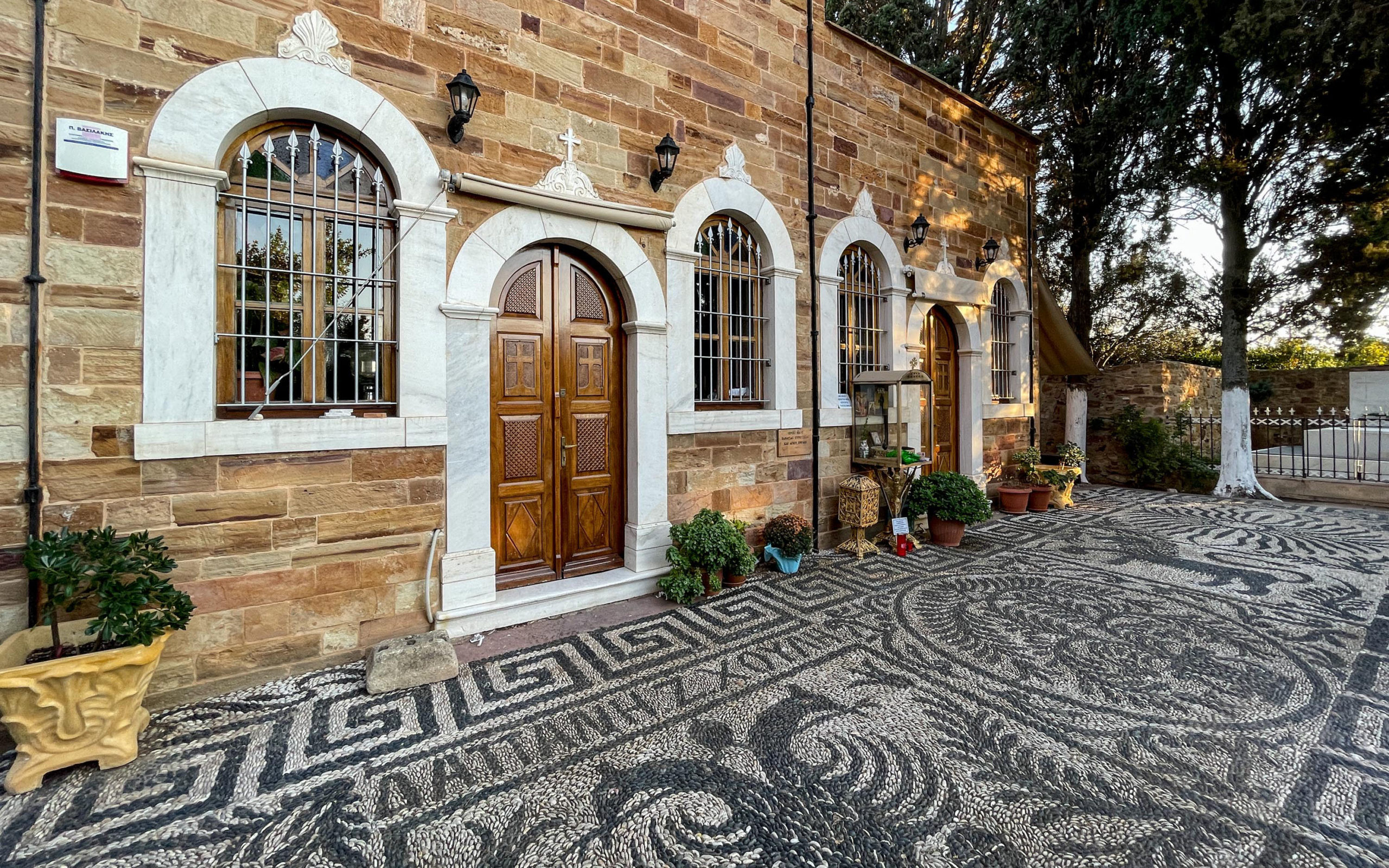
Unlike a typical Greek village, Kampos has no central square. Instead, 38 churches and a few stone seating areas serve as public gathering places. Most of the churches go back to the 17th and 18th centuries and were owned by aristocratic families. The Church of Panagia Syriotissa, built by Fragoulis Kazanova in 1648, is a two-aisled basilica with an elaborate votsalotó courtyard where the poet Aristeidis Karavas is buried.
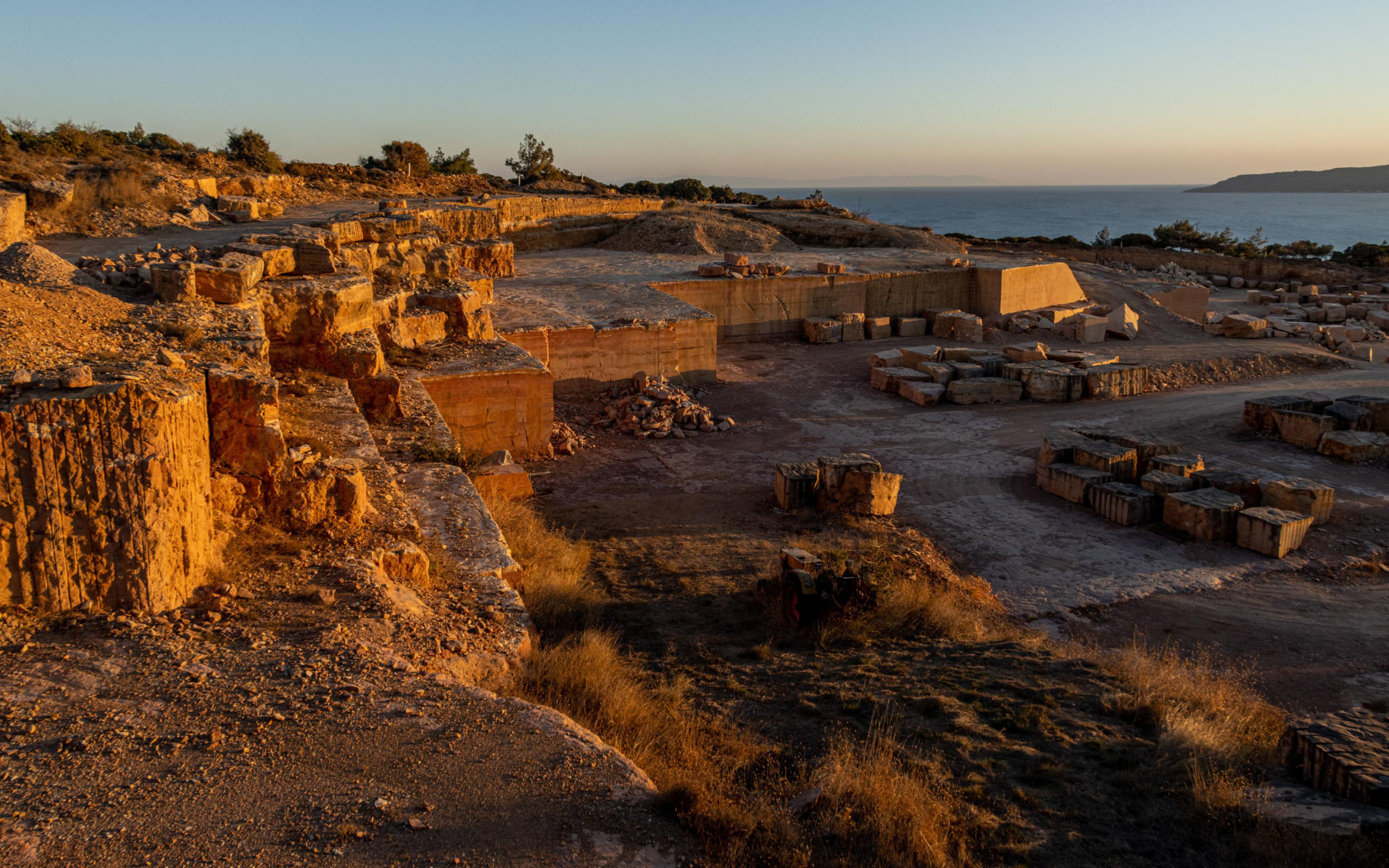
Porous, fine-grained limestone, whose earthen colors range from ochre to bruised purple, gives the neighborhood its distinct character and is used to construct walls, mansions and churches. It is quarried from the village of Thymiana, just south of Kampos. Architects can discern the approximate age of a building by the stratum of the stone and the tools used to mason it.
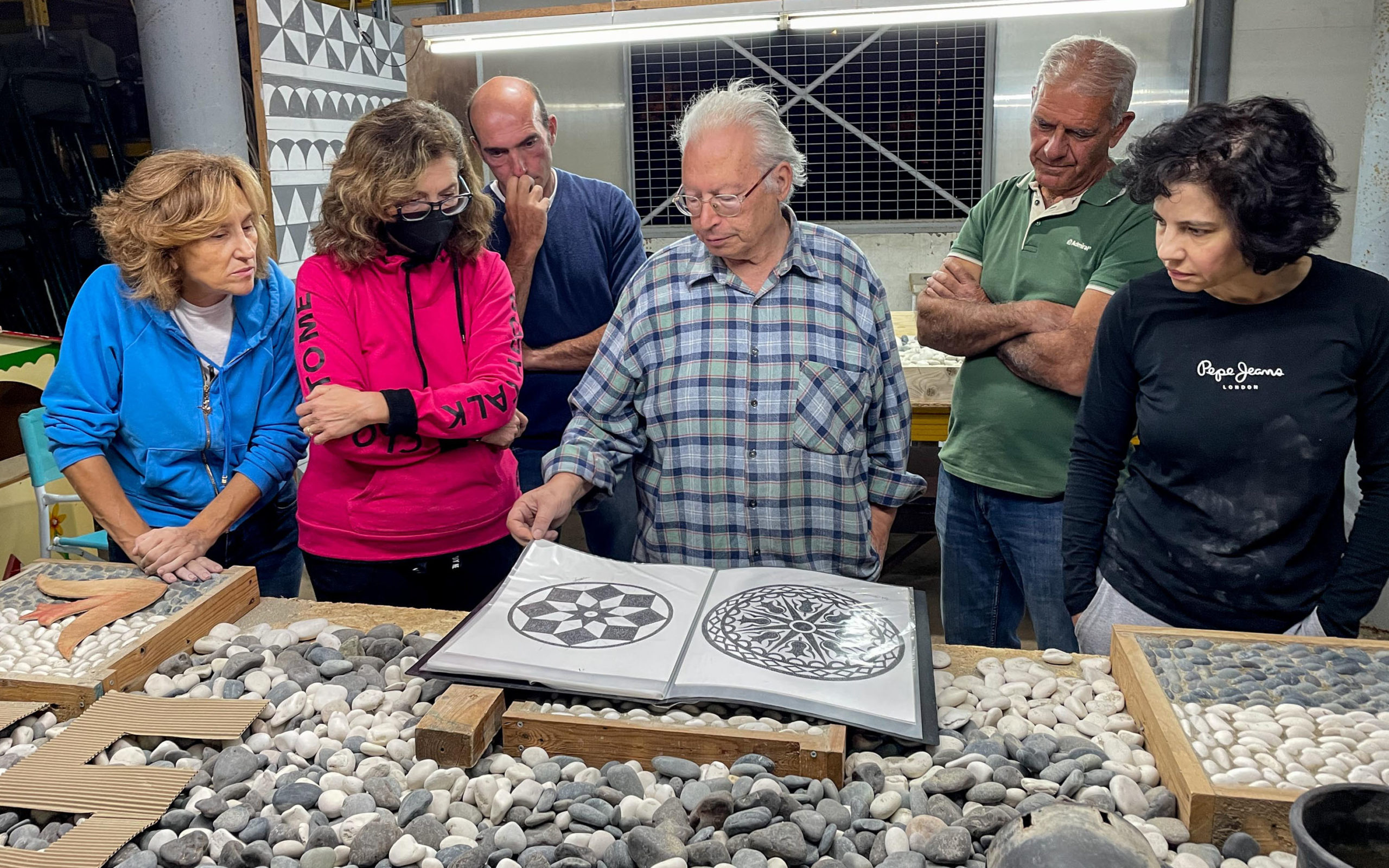
Giorgis Mastorakis, author of the guidebook Cultural Routes in the Kampos of Chios, invited me to a votsalotó workshop he was running for the Homerion Cultural Center. “In a courtyard, all pebbles have a place,” one of our instructors said. We started with the most basic design: a line with black pebbles on one side and white on the other. As I pushed pebbles into the damp sand, starting at the edges of the square frame and working my way inward, I discovered how difficult it was to puzzle the stones together. I’d pick one up and put it down, unable to judge how tightly it fit with its neighbors. It seemed your fingers had to develop a familiarity with the stones, a knowledge of their sizes and curves, that could only come from experience.
When our instructor hammered the stones into place, we saw that few of our lines came out straight in the end. Giorgis showed us a book full of designs drawn with a compass. “The black and white stones are binary, like a computer’s ones and zeros,” he said. Some of the designs were inversions of others. The black volcanic stones used to come from Mavra Volia beach in southeast Chios; now they’re imported from the island of Nisyros in the Dodecanese. I came away from the workshop with a deep appreciation for this traditional art.
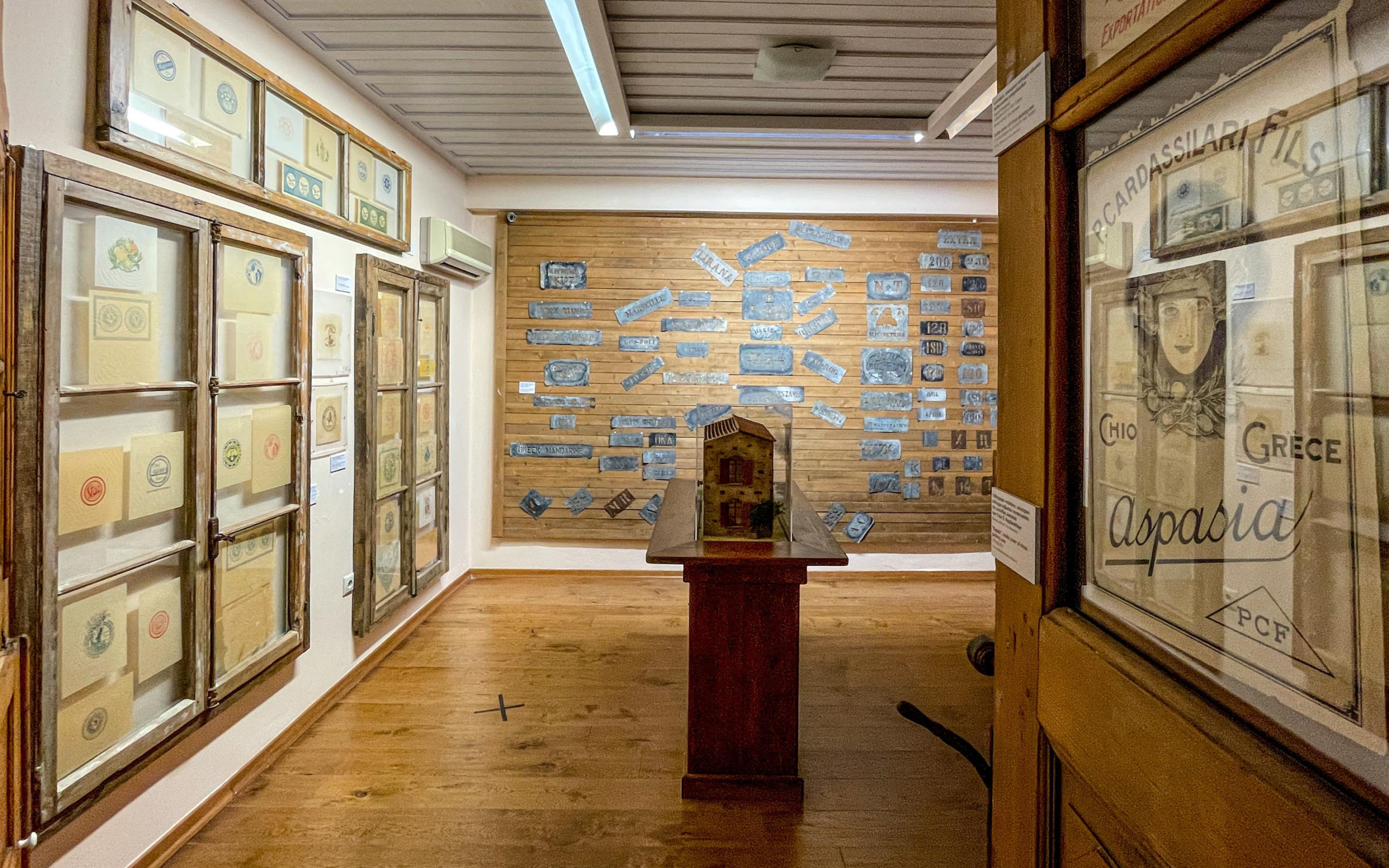
From the Genoese period until the 1960s, citrus fruits were a precious commodity. They originated in southeastern Asia and were introduced to Chios by the Genoese in the 15th century. Bitter orange trees arrived first, followed by orange and lemon trees. In 1850, a terrible frost destroyed most of the citrus trees in Kampos, and landowners brought the mandarin to the island since it is more resilient to cold temperatures. The Chios mandarin (the common Chios variety of the species Citrus deliciosa tenore) is recognized in the European Union as a product of Protected Geographical Indication (PGI), known for its intense aroma and distinct flavor. After citrus prices plunged in the 1960s, it became too expensive for many in Kampos to collect the fruit, and others looked for new ways to profit from their orchards.
The Citrus Museum at the Perivoli estate tells the story of citrus production in Kampos. At its peak in the 17th and 18th centuries, specialized workers dug irrigation canals, pruned the trees, cut and collected the fruit. Women separated the fruit into three categories, polished the rind and wrapped each piece individually in paper stamped with the merchant’s logo. The fruit was carefully crated and shipped as far away as London, Marseille, Berlin, Warsaw, Odessa and Alexandria. This room displays stamped wrapping paper and brands used to package fruit for shipment abroad. Vangelis Xydas’s son Odysseas, the owner of Perivoli, told me the fruit was so valuable “a Russian worker would spend a whole day’s wage to buy an orange to give as a Christmas present to his child.”
Income from the orchards covered production costs, workers’ wages and expenses for the upkeep of the estate. Odysseas’s grandfather, after whom he is named, was the anestátis of the estate, responsible for managing the orchard on behalf of the owner. He bought Perivoli from the Lykiardopoulou-Karali family in 1975 amid concerns that Greece and Turkey would go to war after the latter’s invasion of Cyprus.
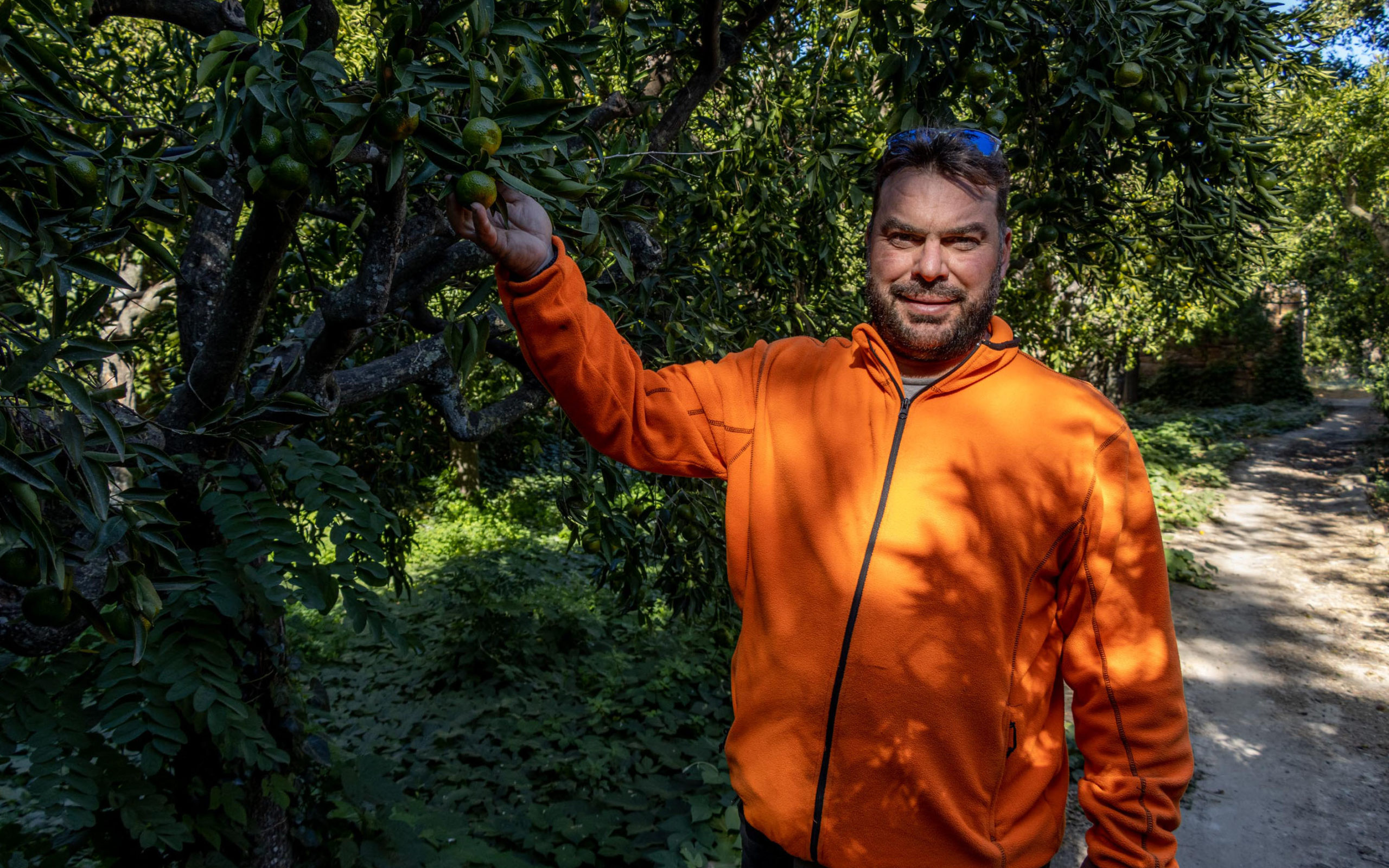
A good relationship between owner and anestátis is essential for the smooth operation of an estate. Antonis Evodias, who hails from Fragovouni, cultivates the 30 stremmata of orchards and fields at the Karaviko as well as more than 70 other stremmata in Kampos. He pays rent to Lia Forou, which she uses for the upkeep of the house, and in return, he can sell whatever he produces. “I really struggled with the farm before finding Antonis,” Lia said. “He’s a very respectful and serious person who loves his work, and I think he’ll grow into a bigger business.”
Antonis sells citrus fruit to supermarkets in Chios and Athens and has a stand at the Saturday farmer’s market in Chios Town. He also sells fruit to Chios Gardens, a large, Kampos-based juice brand. He told me he receives about 50 cents per kilo for Chios mandarins and 18 cents per kilo for mandarins used for juice. Competition with producers from Brazil, Mexico and the United States has driven the price down, and there’s lower demand for Chios mandarins and oranges since they have seeds and are less sweet. Antonis also grows potatoes, carrots, cabbage, onions, cauliflower and olive trees. But this year, production costs have risen drastically, draining away profits. “Fertilizer, seeds, electricity, oil—they’ve all gone up this year,” he said. “If I work day and night only to earn the same wage as my workers, what’s the point?”
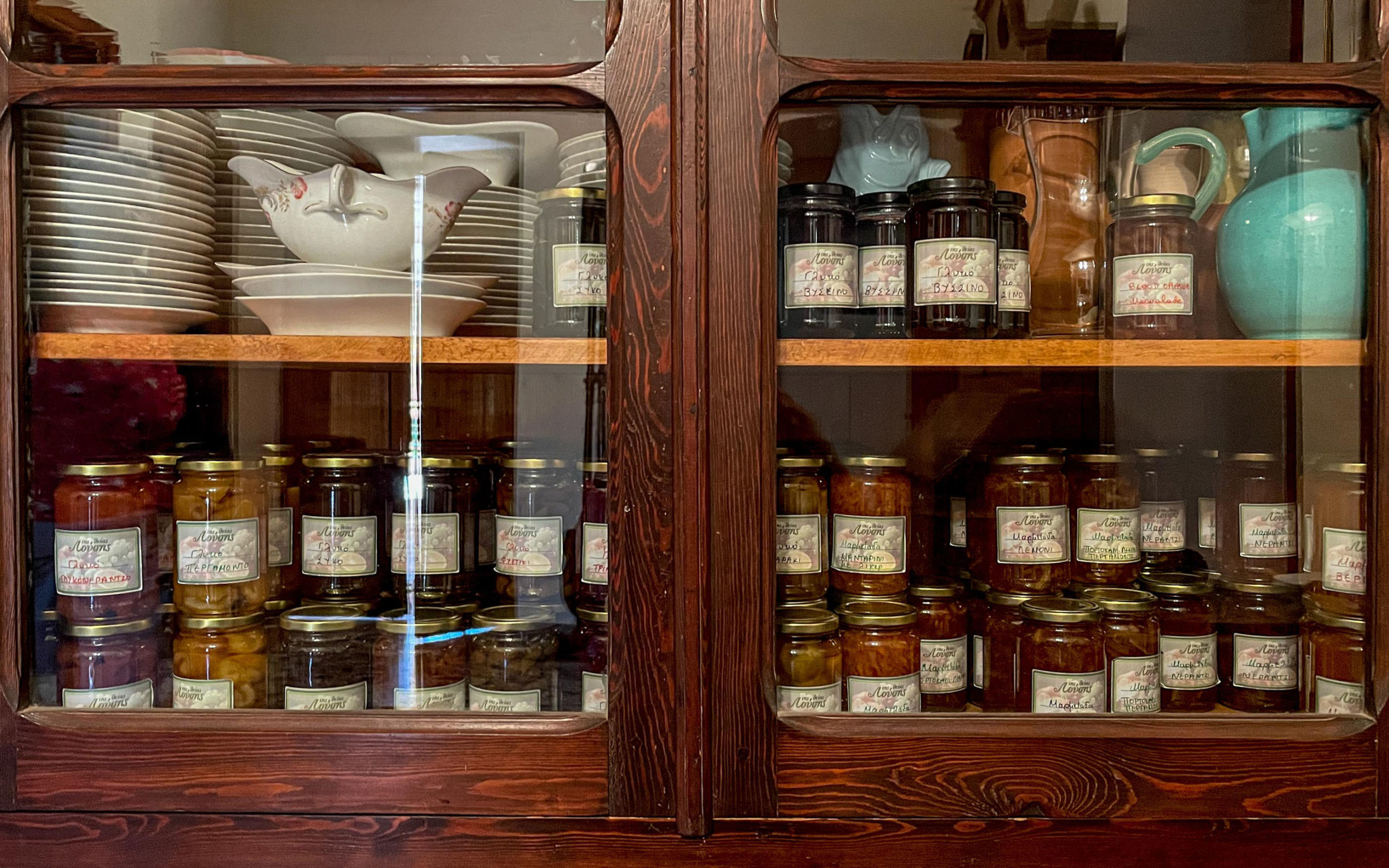
Citrus trees produce lots of fruit in a short time span, more than one family can possibly eat. So what happens to it all? Due to low market prices, it often isn’t worth it to pay workers to collect the fruit, so much of it falls to the ground and decomposes or gets eaten by rats. The Argentiko has some 2,800 trees and donates fruit to the army and nursing homes rather than sell it. Many residents also excel in producing glyká tou koutalioú or spoon sweets, a tradition that enables them to preserve part of the harvest by boiling the fruit in sugar syrup. Spoon sweets are a staple of Kampousiki hospitality.
Every time I visited an estate, the owner greeted me with a cold glass of water and a dollop of homemade spoon sweet on a tiny, ornate crystal dish. Magda Zannikou served me an aromatic coil of bitter orange peel glazed in golden syrup. Margarita Martaki, president of the Progressive Association of Kampos, gave me a jar of grape spoon sweets with a twist of bergamot, whose plump, velvety skins I pressed between my tongue and the roof of my mouth. And Lucy Vandoros let me choose a jar from her cabinet of homemade spoon sweets and marmalades (pictured), each meticulously labeled. Out on the porch, I sampled rose petal spoon sweets from her garden, whose color she’d perfected.
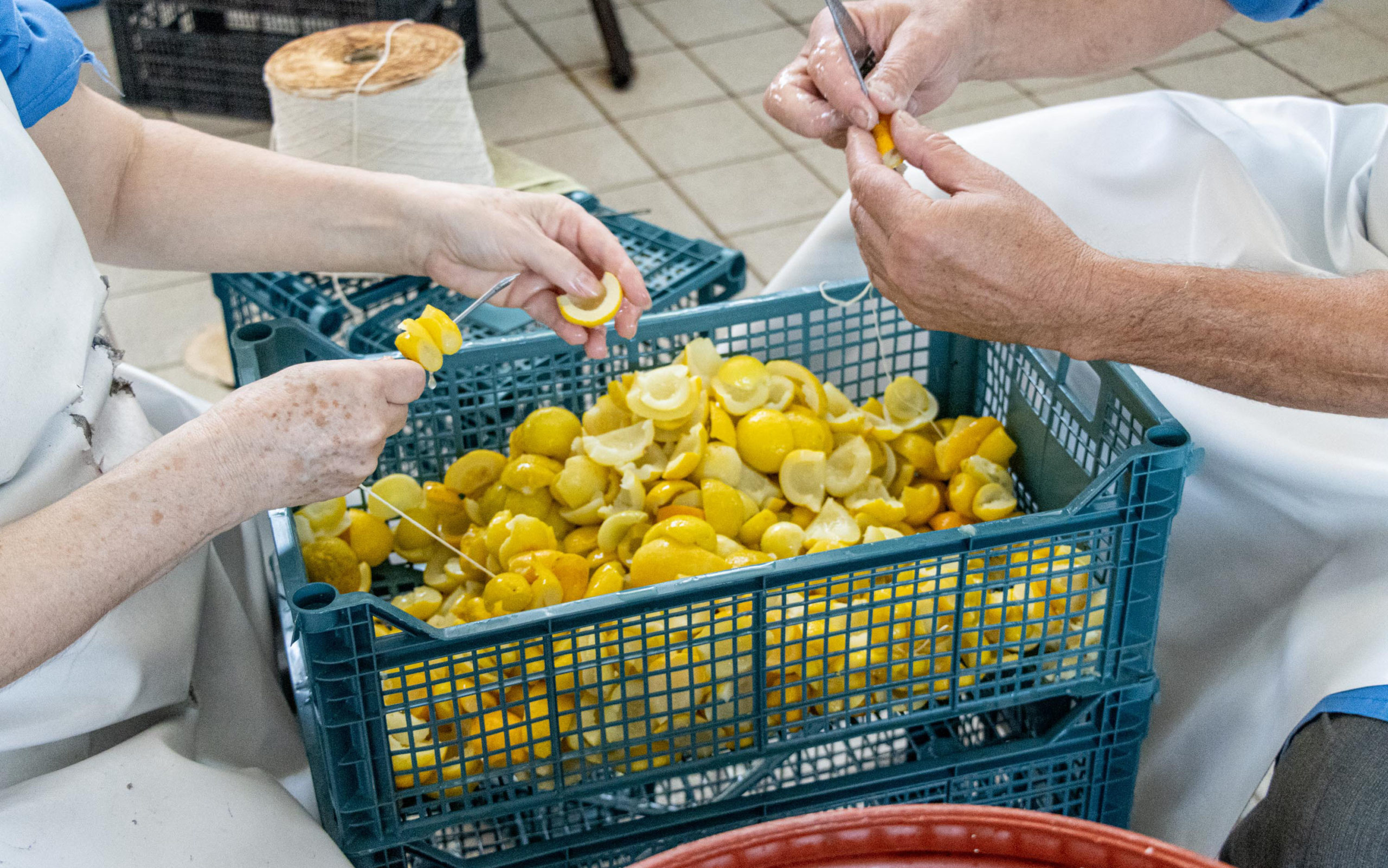
The spoon sweet tradition has developed into a small industry. Many of these companies are family businesses with factories in or near Kampos that source their fruit and raw materials locally. The largest, Sarantis, was founded in 1928 and exports its products to Europe, the United States, Australia, South Africa and Turkey. Korakis-Marinos, established in 1937, produces over 40 different kinds of spoon sweets, marmalades, submarines, nougat pies and concentrated juices. In an estate that formerly belonged to the Schilizzi family, Stefanos Palios and his wife Katerina have run Aunt Evangelia’s Sweets since 2006, using family recipes with no preservatives, just lemon and sugar. Stefanos started the business with his mother, and she posed as Aunt Evangelia—her grandmother—for the company logo.
Finally, I visited the Varlas spoon sweet factory, where workers were stringing together pieces of bitter orange peel before soaking them in barrels. The company was founded by Emmanouel Varlas in 1979 and is now run by his son Georgios. It produces about 200 kilos of sweets per day, a total of 50 to 60 tons per year.
Chios Gardens was founded in 2010 by Damien Zannaras, a retired naval architect with roots from the island. He bought an old factory from the Chios Citrus Growers Association and rebuilt it with brand new, state-of-the-art machinery. Because orange and mandarin production in Kampos is not large enough to meet the factory’s demand (in part because not enough owners are incentivized to tend and harvest the orchards), Zannaras buys the same fruit from the Peloponnese and mixes them together in a ratio of about fifty-fifty. He told me that despite rumors to the contrary, “All the factory’s citrus fruit comes either from Chios or the Peloponnese. Nothing whatsoever comes from abroad.” He offers to pay locals double what he pays in the Peloponnese, but many are still dissatisfied with the low prices: about 11 cents per kilo for oranges and 18 cents for mandarins. Chios Gardens also exports juice abroad, especially to South Korea and the Philippines. While I was touring the factory, workers loaded a crate with boxes of “Greek Style Tart Cherryade” bound for supermarkets in South Korea.
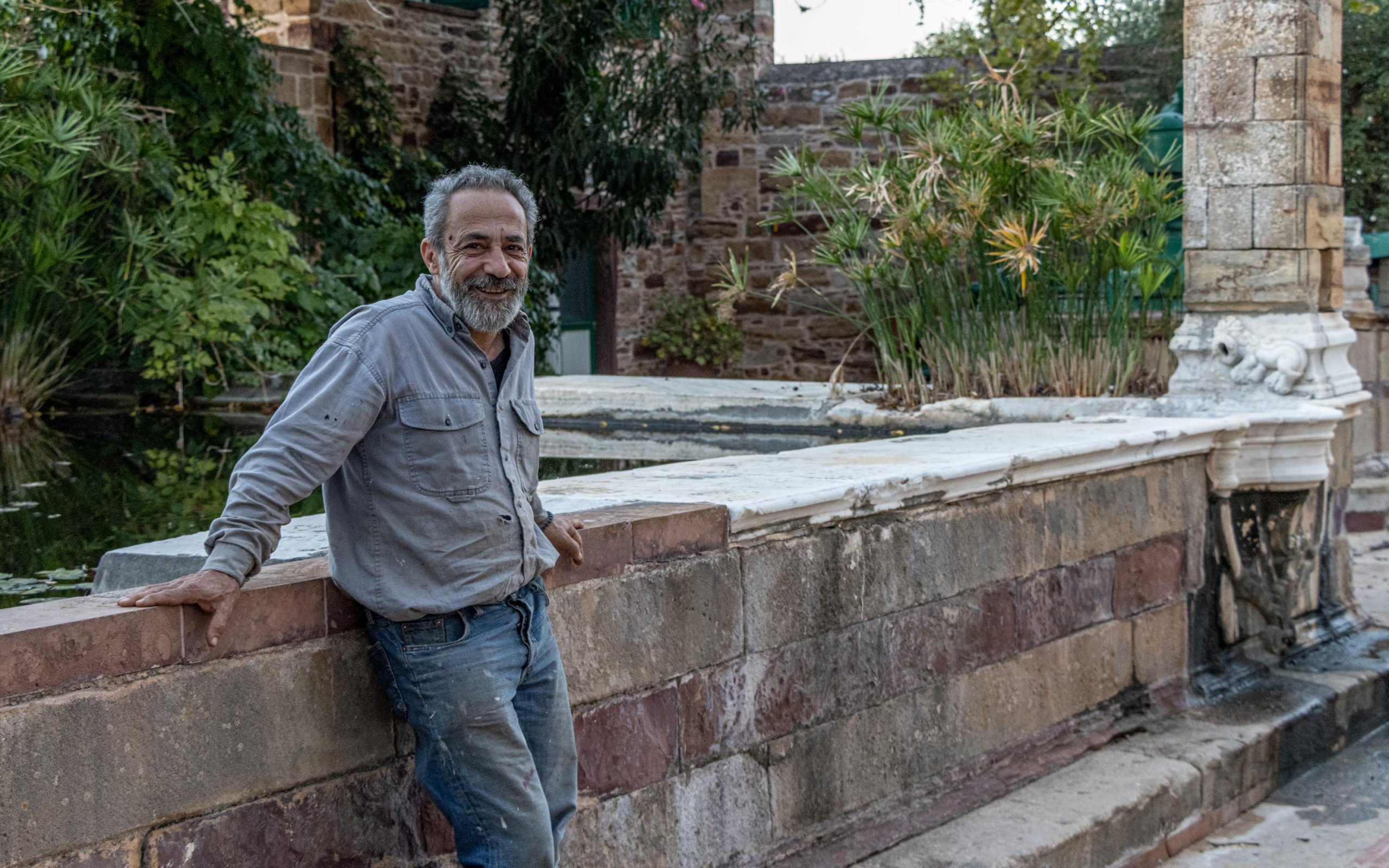
Vangelis Xydas, whose father Odysseas managed and eventually bought Perivoli, has dedicated his life to Kampos. He is a soft-spoken man with worn hands who emerged from the 1,100-tree orchard for our meeting and disappeared back into it afterward. Odysseas was also the anestátis at the Perleas estate, which Vangelis has run as a guesthouse for over 30 years. Perleas’s citrus grove is certified for organic farming, and Vangelis has made many attempts to wring profit from the fruit. “The old model of exporting fruit and making juice, that’s finished,” he told me. “You need something new, something smart.” In addition to making spoon sweets and mandarin juice that his son sells at Perivoli, Vangelis has produced essential oils and a mandarin puree for renowned Greek confectioner Stelios Parliaros. Chios Gardens featured him in a commercial as one of their producers.
Still, he insists fruit alone won’t save Kampos. “We talk and we talk about citrus fruit, but you can’t live from them, even if you sell them at one euro per kilo,” he said. “All that you see here wasn’t made by money from mandarins. It was made by huge businesses abroad.” While he’s optimistic Kampos will eventually find its way, it will take hard work, investment and risk.
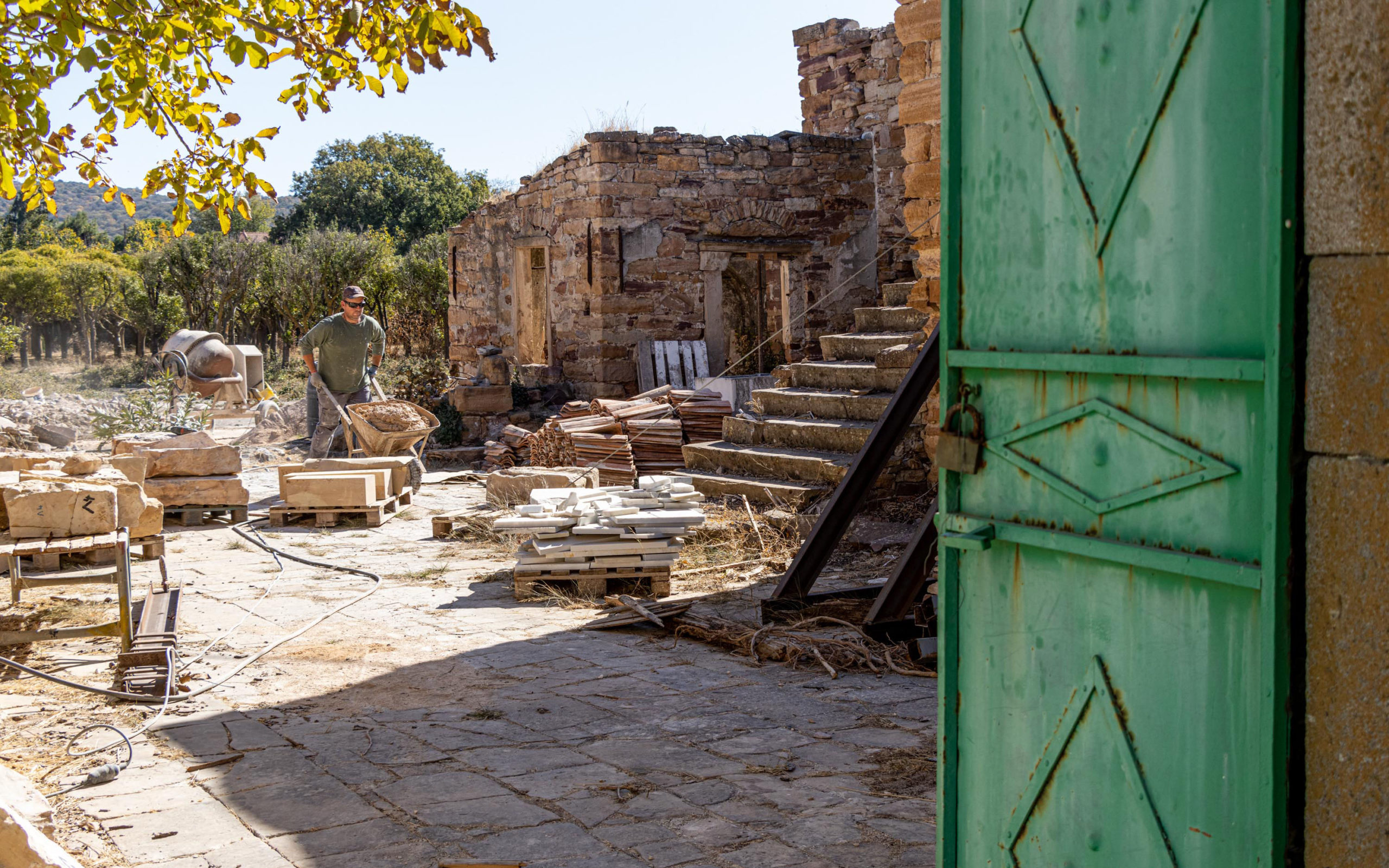
Kampos faces several threats to its long-term sustainability, as outlined in the 2016 Europa Nostra report. First, the over-extraction of groundwater via mechanical pumps and the turn to more lucrative but water-intensive crops like potatoes has depleted the water table and increased its salinity.
Second, although Kampos is a protected area, loopholes in planning laws have allowed developers to build modern villas that disrupt its architectural cohesion. Since 1927, Chios Town has gradually encroached on Kampos, and construction of the airport in the 1960s cut off its access to the sea.
For the region to survive, residents will have to develop new revenue streams for their estates and work together on a holistic plan for the neighborhood, while lobbying to close permitting loopholes, reduce through traffic and regulate water use. Vangelis envisions Kampos as a future cultural center with galleries, a library, an artisanal bakery and estate-based shops selling handcrafted furniture and organic local products. It remains to be seen whether this dream can become a reality.
Paradoxically, the estates of Kampos were never meant to be profitable. The luxurious country homes were status symbols into which mercantile families poured wealth from abroad. Vangelis estimates that renovating an estate today can easily cost one or two million euros. They require constant upkeep, and the most impressive estates I visited employ year-round staff to maintain the property and cultivate the orchards and fields.
In its heyday, citrus production covered an estate’s costs, but with demand in decline, that’s money most permanent residents don’t have. Many can’t afford to repair walls and structures damaged by frequent seismic activity. Here, under the direction of Manoliadi and Vournous Architects, workers stabilize a ruined mansion that once belonged to the Ralli family. Its new owner is a Greek American.
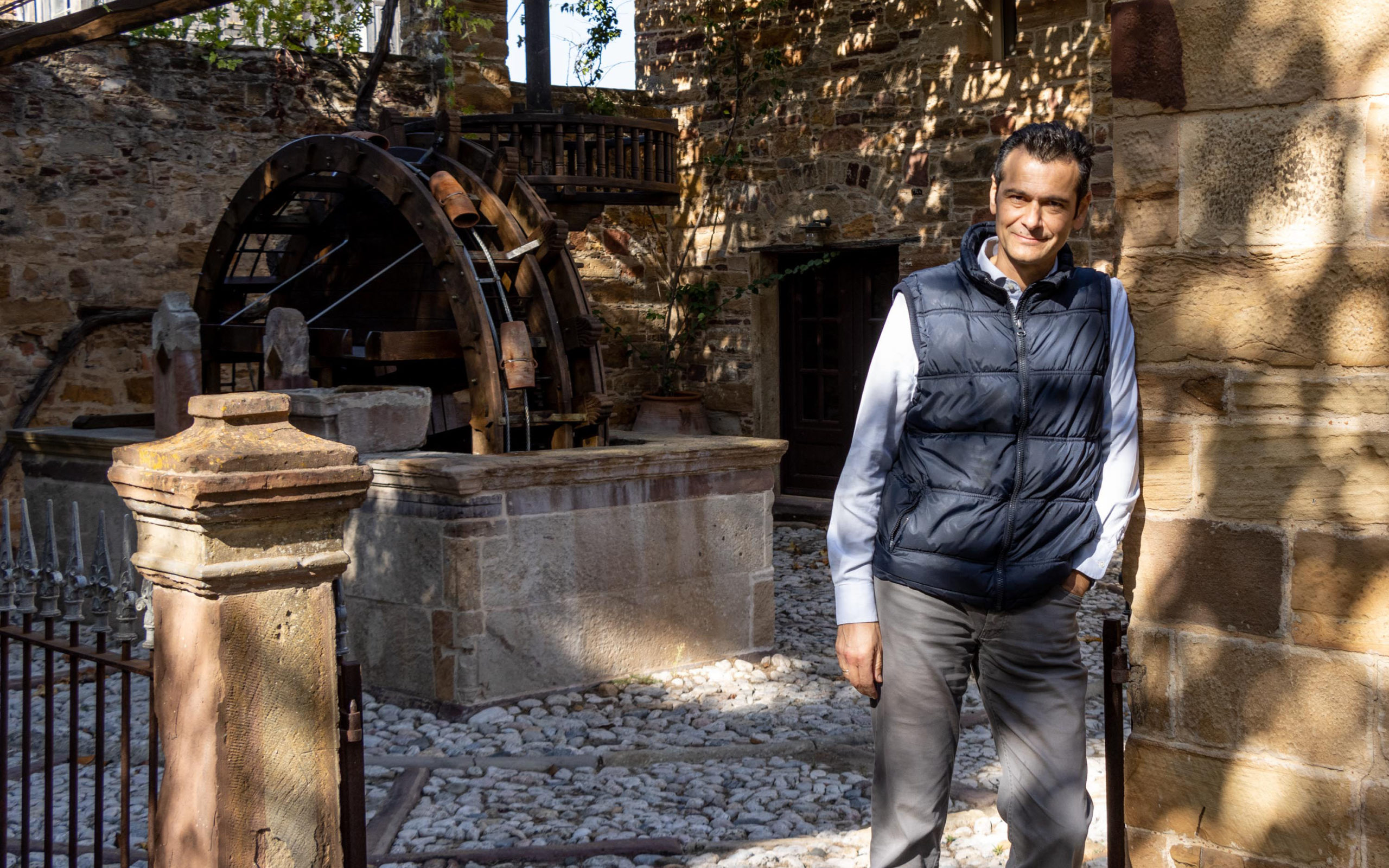
According to architect and former mayor Manolis Vournous—who is also half of the team that restored the Antouaniko estate—Kampos has attracted several shipowners who have bought estates and invested money to restore and maintain them in the last 20 to 30 years. That replicates the pattern of foreign funding from earlier periods of Kampos’s history. Both Antouaniko, which won the 2015 European Union Prize for Cultural Heritage / Europa Nostra Award, and Perleas, which reputedly has the best preserved and most prosperous orchards, belong to the Prokopiou family, Greek shipowners with ties to Chios.
When I entered the Antouaniko, I couldn’t believe my eyes. Terracotta buckets brought up water from the well, and it gushed from marble spouts into the stérna. Tall trees shaded the votsalotó floor, and the white trunks of the mandarin trees stood at attention. Manolis and his partner had kept the patinas and traces of the past. Viewing the estate as dynamic and organic, they focused on maintenance rather than replacement and sought to accommodate the natural environment.
I was pondering how I might keep the ring of keys I held in my hand when Manolis brought me back to earth. “There’s not one single estate in Kampos that makes money,” he told me. “You must invest a lot of time, a lot of capital, in order to make even a little bit of money back, growing slowly like Perivoli or Perleas. But you can’t grow beyond a family business, and it depends on your ability, skills and personality and the genius loci of the property.”
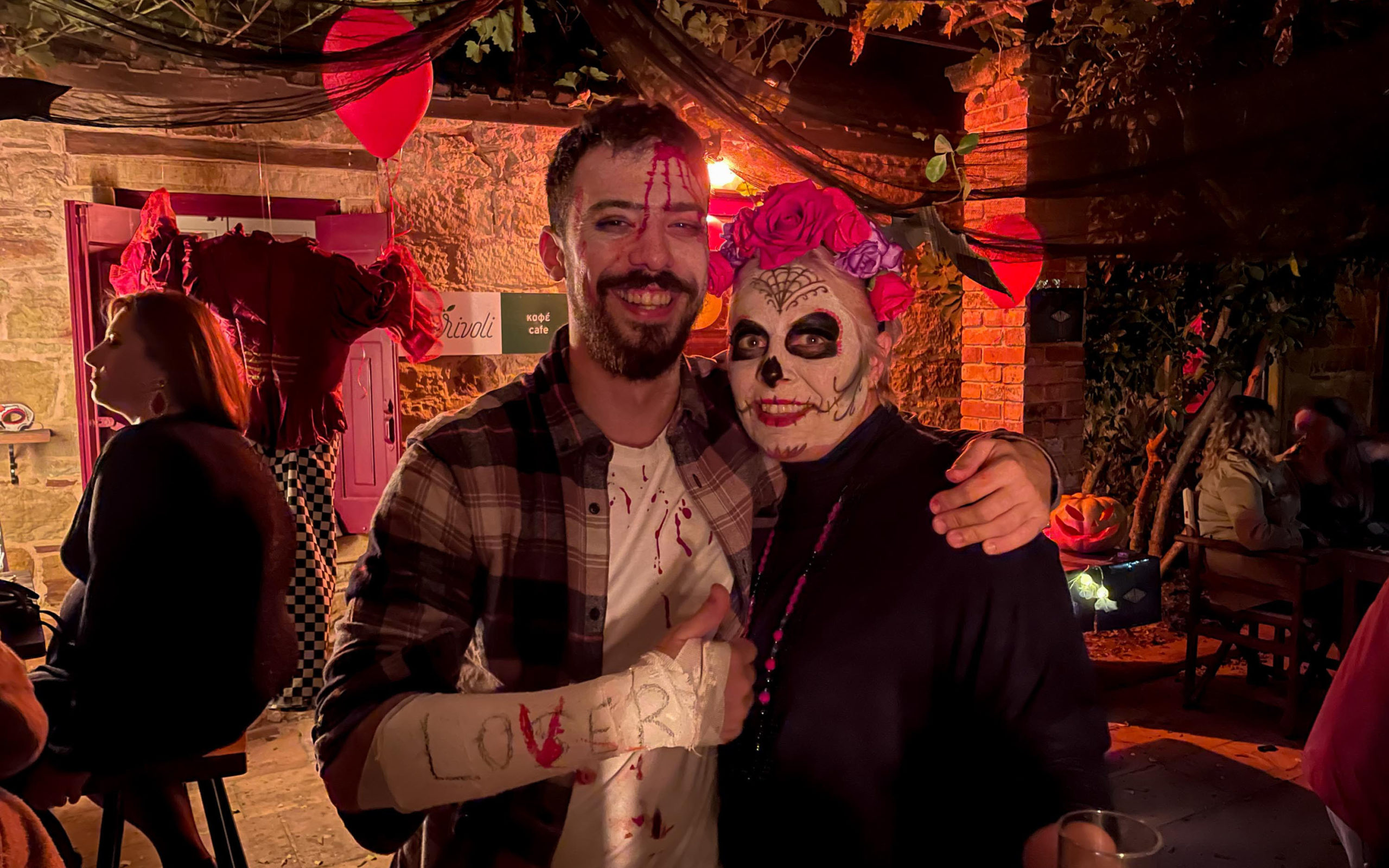
Odysseas Xydas (left) owns Perivoli, the only estate open to the public every day and a model for what Kampos could become. It hosts the Citrus Museum, a starting point for anyone interested in the neighborhood, and a friendly, sophisticated cafe that has become a treasured local haunt.
Throughout the year and especially during the summer, Perivoli hosts parties, film screenings, concerts, readings, photography exhibits and weekly aperitif nights. This year, Odysseas organized a Halloween party with food from Mavro Provato, a cafe in northern Chios. The last time I visited, he had spent a week transforming the estate into a festively lit winter wonderland.
He plans to expand and modernize the museum and open a secondary building with a library and rooms to host artistic events. He also wants to bring Vangelis’s spoon sweet factory to Perivoli so visitors can see the sweets being made, sample them and shop all in the same place.
Odysseas, who studied shipping management, will present an investment plan to several shipowners to raise the necessary funds, which he estimates at 500,000 euros. “When I took over, I tried to make a space for locals too, not just for tourists,” he said. “My goal is to offer something for everyone.”
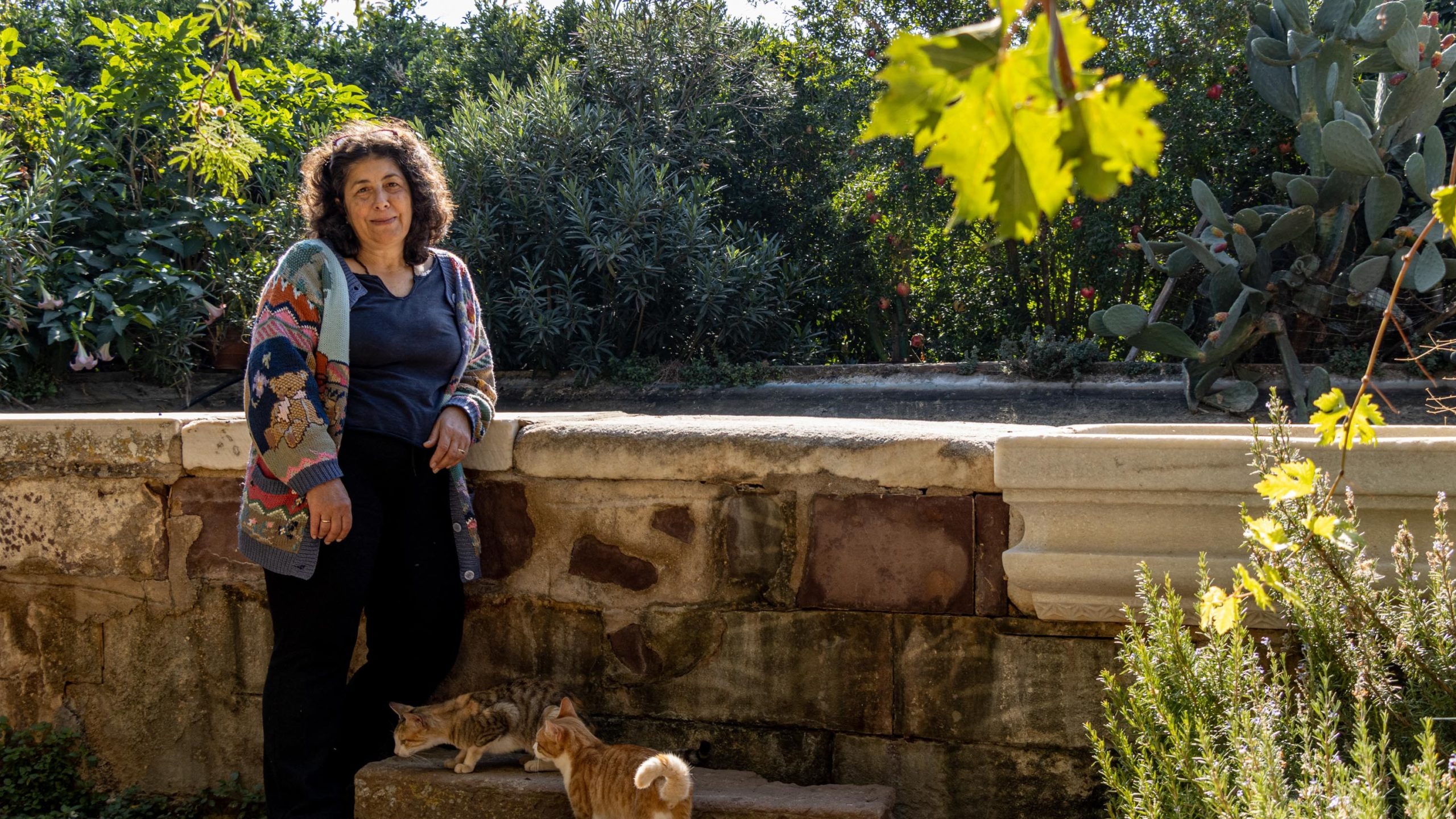
Dimitra Apessou, owner of the Astrakia estate, remembers when Kampos had dirt roads and no electricity. “Those are joyful memories,” she told me. “We gathered inside early with glass oil lamps. I had my animals: my dog, my goats, and most of the time I played with them.”
She used to work at the Chios Citrus Growers Association and took advantage of a 1996 agritourism program and subsidy to turn her estate into a guesthouse. “It was very difficult because I was the contractor and didn’t know what to do,” she said. “I had to find the right people, review everything and make decisions. I remember one night I was very upset and went out walking in the orchard late at night. I thought, God, help me! What am I going to do? How am I going to finish it?” Astrakia opened in 2000, and the first years went well, but then the financial crisis hit and rooms weren’t full even during Chios’s peak July-August tourism season.
Now Dimitra is considering adding kitchenettes and other amenities to the rooms so they can be autonomous and host longer stays. She still keeps animals on the farm: a family of cats, two aged golden retrievers, sheep, goats and a white mare named Angie. “Since I grew up with animals, I have a connection with them,” she said. “Animals give life to a farm—of course, they also do their little damages!”
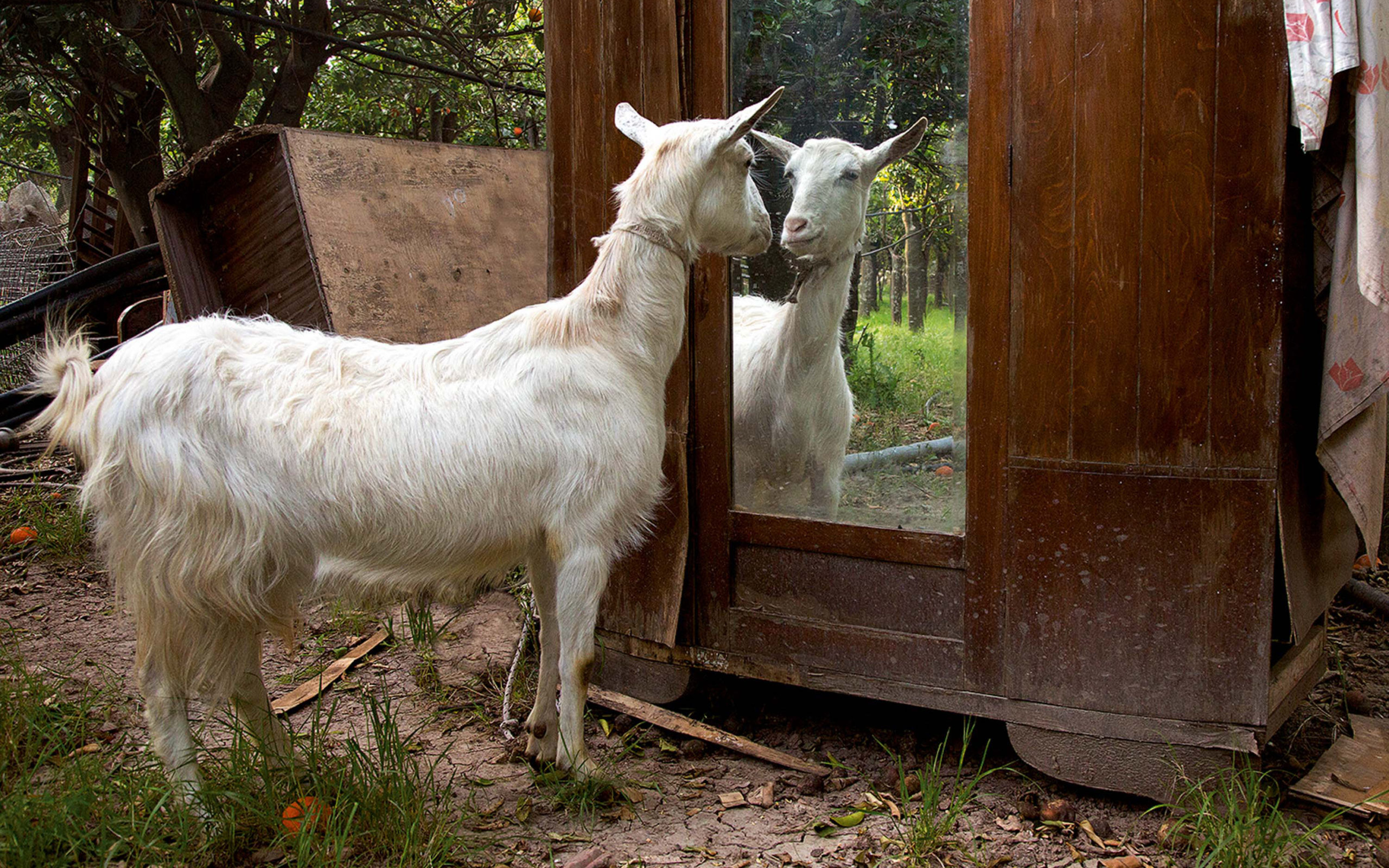
For photographer Stratis Vogiatzis, who spent his childhood in Kampos and whose “fictional portrait” of the neighborhood won the prize for best photography book at this year’s Nordic Light Festival of Photography, Kampos is a “hidden place” where “exploration and adventure” reign. The tall walls that afford residents privacy and protect their citrus trees from the wind stimulated his imagination. In the shadow of the climate crisis, he felt the project mutate from a record of life in Kampos to a meditation on ecology, animism and symbiosis.
Like Kampos itself, the book adopts a hybrid stance between historical fact and memory, between the constructed and natural worlds, which move alongside each other, always touching until one overcomes the other. In Kampos, Stratis looks to animals for “survival techniques in a traumatized planet.” As in this photo from his book, he found they often appear out of nowhere and give people a way to move forward.
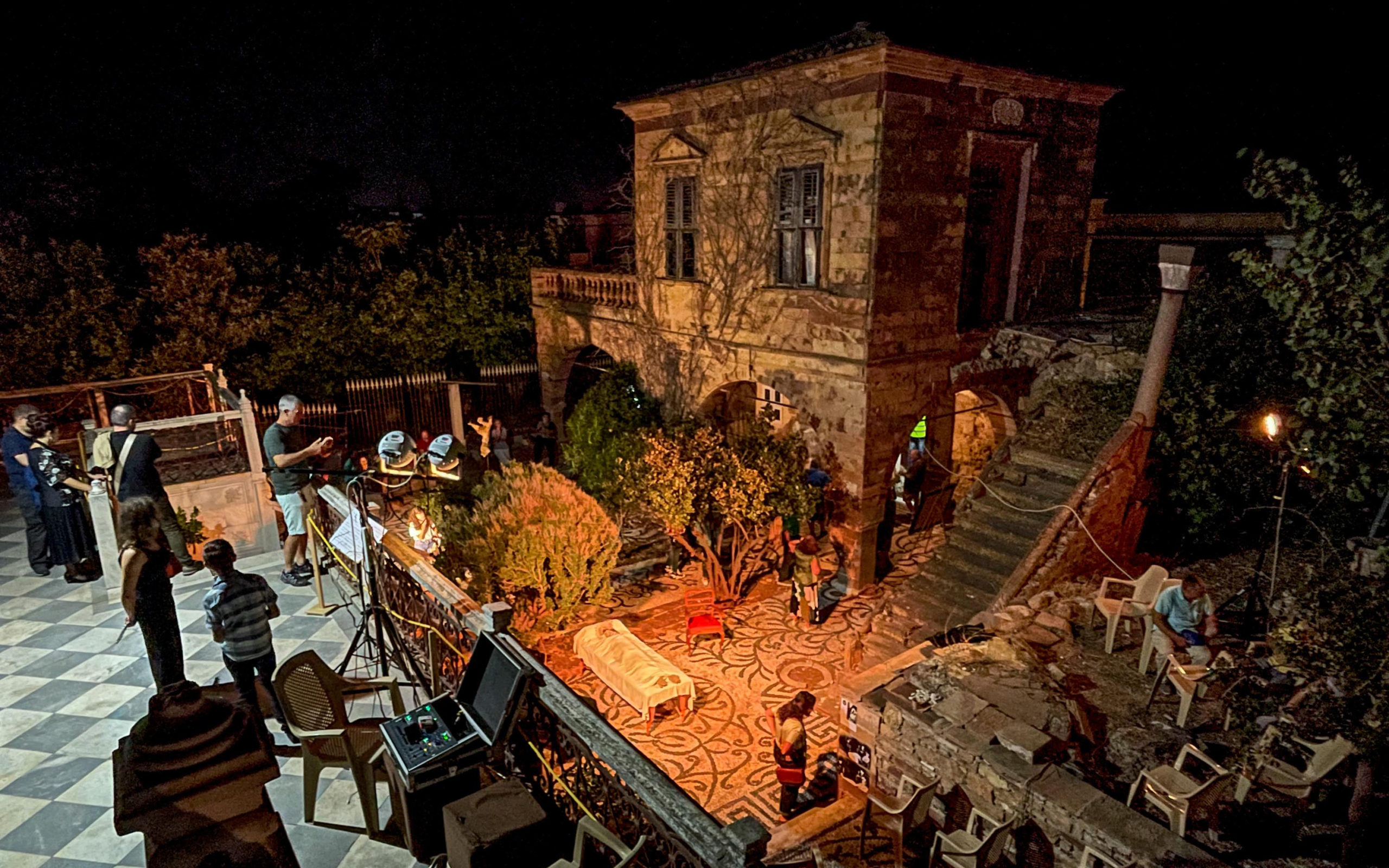
At the end of September, islanders flocked to the Zygomaladiko estate for #ekipouzo, a three-day art festival curated by Maria Zannikou, Marousa Mamma and Nausika Saliari, and co-organized by the Progressive Association of Kampos. The festival featured over 50 local artists, writers, musicians, photographers, filmmakers and performers who spent several months creating work inspired by the estate.
Each night was packed. The enthusiastic public reception reminded me of something Vangelis had told me: “When we created the museum at Perivoli, I realized what a great need people have to go inside an estate and see it,” he said. I felt this intense curiosity myself. Each time someone opened their gate to me, an entire world and life was revealed. Some were manicured Ligurian gardens, others wild havens for beloved animals. Each had a human face.
The Zygomaladiko was a masterpiece, as carefully crafted as the art it inspired. I understood then why so many Kampos residents, past and present, painted, wrote, or worked with their hands. The neighborhood nurtured creativity, which gave me hope for its future. We gathered in the courtyard to watch a short performance, then wandered the grounds admiring the architectural details and site-specific art. We were, for the night, Kampos insiders, and I hope if we could share in the awe of the place, we could also share in saving it.
A version of this essay was published by New Lines Magazine.
Top photo: The grand staircase at the Karaviko estate leads to the main entryway on the second floor with a balcony overlooking the courtyard. From there, you can see over the orchard, an uninterrupted sea of green. Residents customarily planted trees to mark new births, so in these gardens, you can find palm trees and Black Sea pines they brought home from their travels. In most of the mansions I visited, an auxiliary staircase exists on the side of the house, leading to a kitchen or breakfast nook. This estate once belonged to the Greek banker and benefactor Andreas Syggros, and notable writers Emmanuel Roidis, Yiannis Psycharis and Aristeidis Karavas lived there

